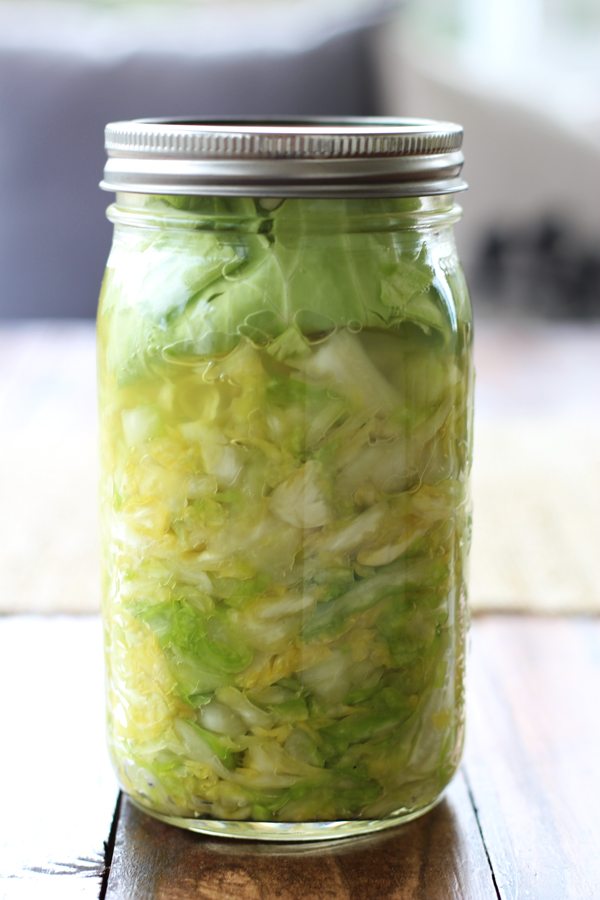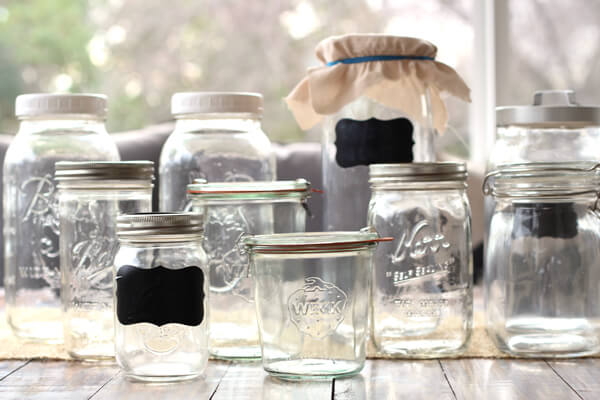
Fermented vegetables should be eaten daily to aid in digestion, heal the gut and aid in the absorption of vitamins and minerals. Making sauerkraut is one of the cheapest and easiest fermented foods you can make and it’s versatile.
Sauerkraut goes well with many foods. It’s not just for bratwurst or hot dogs. I add it to burgers, sandwiches, eggs, avocado toast, eat it with chips, pile it on baked potatoes, salads and serve it as a side to every meal I eat.
Cabbage and salt make up the ingredients for sauerkraut. Veggies, fruit, spices and herbs can be added to make different variations of sauerkraut including kimchi. Unlike salt brining where we make a salt water brine and then add the vegetables, we will use a dry salting method to make sauerkraut.
The salt is mixed and massaged either with your hands or a vegetable pounder into the cabbage. The salt draws out the liquid from the cabbage creating its own brine.
Once the liquid is drawn out of the cabbage, it’s packed tightly into a mason jar and becomes submerged under its own juices, creating an oxygen-free environment where lactobacillus bacteria can thrive and bad bacteria cannot.
The acid from the bacteria give the sauerkraut it’s tangy, sour flavor. There are many vegetables and spices that go very well with sauerkraut. My favorites are adding ginger for a simple variation or adding several veggies and spices to make a kimchi or my favorite, Pineapple Turmeric Sauerkraut.
Tools You’ll Need To Make Sauerkraut

There are many different types of jars, crocks, containers, slicing tools and gadgets that can be used to make fermented foods.
For the purpose of keeping it simple, you’ll only need
- 1 Quart sized mason jar
- A knife
- Cutting board
- Sea salt – I highly recommend using Fine Celtic Sea Salt or Himalayan Salt.
- Cabbage and other ingredients from recipes below
- Airlocks, Weights, Or Vegetable Pounders make it easier, but are optional.
How To Make Sauerkraut
- 1 Head Of Cabbage
- 1 Tablespoon Of Sea Salt
- Pull 3 outer leaves off the head of cabbage, set aside and cut cabbage in half.
- Remove the cores from the cabbage and set aside.
- Cut the cabbage into thin strips and place in a large bowl. You can also use a food processor or cabbage shredder for this step.
- Add the salt to the cabbage. Using your hands, mix and massage (squeeze) the salt into the cabbage for 5 minutes. Set the cabbage aside and let it sit for 15-20 minutes so the sea salt has time to draw out the liquid and make the cabbage soft.
- Mix and squeeze the cabbage until it's soft and when squeezed juice comes out. If you want to add other veggies, spices or herbs to your kraut, do it in this step. Mix and squeeze them with the cabbage.
- Pack the cabbage in the mason jar tightly with either your hand or a vegetable pounder. Push it all the way down until it submerges in its own juices (this is the brine).
- Fill the jar until there is about 1-2 inches of space from the top. Pour the rest of the brine into the jar to cover the cabbage in brine.
- Take one of the cabbage cores and place it on top of the cabbage. This will act as a weight to keep the cabbage submerged under the brine. Or use a fermentation weight to keep it submerged.
- Roll up one of the outer cabbage leaves you set aside in step 1. Stuff the rolled up cabbage leaf on top of the cabbage core. This will keep the sauerkraut under the brine.
- Screw on the jar loosely so gas can escape as fermentation takes place Or use and airlock lid. Set on the counter for 5-7 days in a cool, shaded place.
- Place a plate under the mason jar in case it bubbles over and makes a mess.
- During fermentation the sauerkraut will bubble, become dull in color and the brine will get cloudy. When ready, store the sauerkraut in the refrigerator. Remove the rolled up cabbage leaves and toss in the garbage before eating. Sauerkraut will last for several months.
How To Tell Your Sauerkraut Is Fermenting
- The sauerkraut will become duller in color.
- The brine will become cloudy.
- Small air pockets will form.
- When you open a lid (if it was closed tight in the first place) gas will escape making a hiss sound.
- It will take on a tangy flavor.
Cabbage head size/weight. All of my kraut recipes reference the amount of salt used is measured by the weight of the head of cabbage. I see that your recipe states 1 Tbs salt per head of cabbage. Because heads can come in very different sizes, 1 lb to 5, can 1 TBS of salt per head of cabbage produce consistent results?
And a TBS of salt will vary in weight due to differences in grain size. It isn’t rocket science but salt by weight to cabbage by weight would be much more informative.
Thank you. I am a scientist as well so your precision to measuring is comforting.
Maggie, This is probably too late, but I simply use 1 tablespoon of Morton’s non-iodized salt (inexpensive) per head of cabbage regardless of size. Apparently, from what I read, the acceptable ratio of salt to cabbage is quite broad. In other words, this isn’t watchmaking.
My brother’s recipe says, “Salt to taste.”
He has a crock with a water moat around the top that the lid edge sits in – that’s his air lock. I use wide-mouth quart jars with air locks in the screw-on lids. As long as we use our equipment with air locks, we never have a failure (rotten and moldy kraut).
My wife won’t let me ferment it in the house so I have to keep it in the garage. The last batch was fermented at temperatures above 85 degrees and possibly some of the time in the 90s. It came out OK. I have to deal with the conditions I’m presented with so I figure that if I have a failure, it’s just one head of cabbage and I learned something.
PS: I’ve never seen a 1 lb head of cabbage in a store. How much cabbage does it take to fill up a quart jar to the correct height after it’s been salted and wilted for a while? That would be the amount of cabbage for 1 tablespoon of salt. For my cabbages, that’s always about one head. But I buy them in the store. I don’t grow my own.
It is never too late for recipe improvement and advice. Thank you, I like your explanation. I was concerned that the amount of salt per pound would be important. It is comforting to know that 1 Tb per head, any size is ok. Many of the recipes use so much more and results in a very salty kraut and salt to taste advice is too broad for me because personal taste varies.
I totally agree :)
Or you could read this article:
https://www.fermentedfoodlab.com/3-simple-steps-to-make-perfectly-salted-sauerkraut-every-time/
Great, thanks. I had read this before but your response below brought more clarity to the article. Keep fermenting…all good stuff. I’m cranking out dill pickles as fast I can.
I like how you add the removed core and outer leaves to hold down the fermenting cabbage and then put on the lid. Much easier than using the glass weights, covering it with a cloth, and having to push it down every day.
Yeah it’s very convenient :)
Is it true refrigeration kills the gut-healthy qualities of sauerkraut? I have read German cooks say any kraut that has not aged at least 5 years is called coleslaw. How does the crock method of sauerkraut work, that is not refrigerated? Seems like this would be possible with 1/2 gallon Mason jars? I have tried your simple method of kraut, but would like to try large batches in crocks too.
What would the salt ratio be if i used green and red cabbage plus carrot? Do I still do the taste test?
Same salt ratio and yes do the taste test.
I use a Gartopf crock, a veg pounder, weights and the basic cabbage/salt combo. My latest batch has me puzzled and concerned. The kraut burped away for a couple of weeks then went quiet. I decided to let it age….for roughly 2 months. Zero mold when I opened it. Brine was cloudy. A bit of green coloring was still present. I bit a small piece and it was beyond tangy. More a burning sensation on my tongue. Slightly slimy. I transferred it to jars/refrigerator, and have no idea what to do with it (beyond compost). Never had this happen before, though I’m still an amateur. Any idea what I did wrong?